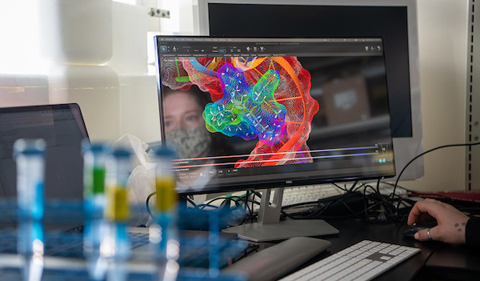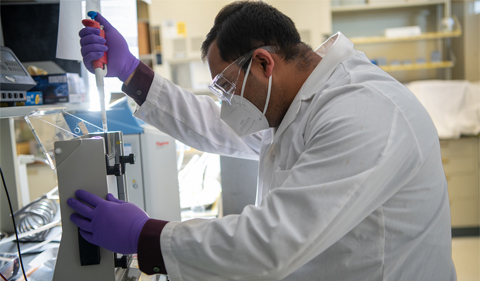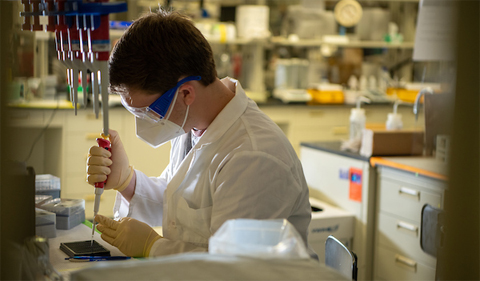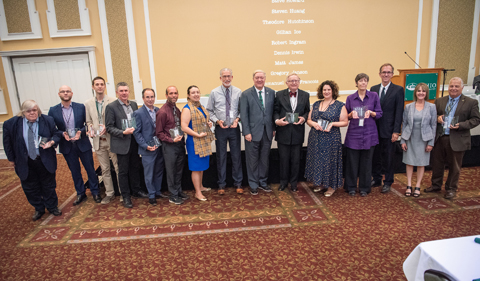When six Ohio University students began their educational careers, none of them thought that before entering the workforce they would be faced with one of the world’s biggest challenges – a global pandemic.
As in-person learning turned virtual, experiential learning in labs seemed to be a faraway opportunity, however, in a few short months these students would not only be back in a lab safely researching, but helping publish an important study on ways to battle COVID.
The students, along with their advisor, Dr. Jennifer Hines, professor of Chemistry & Biochemistry, recently published the first structural biology analysis of a section of the COVID-19 viral RNA called the stem-loop II motif. This paper focuses on their search for another way to stop the virus – by disrupting its RNA and its ability to reproduce.
“This entire project came out of a tutorial Hines taught last spring that discussed the aspects of drug design with computational RNA drug discovery, but when COVID hit and we transitioned to virtual learning, the tutorial acclimated to this new setting, leading us to this research,” said Hannah Boesger, a junior neuroscience major in the Honors Tutorial College (HTC). “Working on this project has been so exciting due to its relevance. We read every day about how COVID is affecting the world, so to be able to have the experience to provide research for future studies on drug discovery is surreal. Science is a team effort and we truly embraced that idea.”
Hines said the tutorial began when Boesger and junior HTC Biological Sciences major Emily Marino came to her interested in stepping outside of their area of study to research drug discovery.
“What’s really neat about the Honors Tutorial College and the programs at Ohio University in general is how easily students can blend courses and do interdisciplinary work outside of their area of study or tutorial,” Hines said. “Through the interests of these women, valuable research and experiences were gained not just by them but by collaborating with other students both on the graduate and undergraduate level.”
As part of their independent study, Hines began to teach the students how to use software that can render a molecule in 3D when COVID hit. She then decided to apply for and was awarded a grant that would allow her to continue to use software and technologies to run calculations and generate the images of how molecules interact with RNA.
“We were extremely fortunate to be granted access to use online databases such as the Ohio Supercomputer while working remote,” Boesger said. “This really allowed us to learn and do computational work, specifically looking at SARS-CoV-2.”
Rather than looking at any RNA, the group decided to look to see if anything was related to the SARS-CoV-2 genomic RNA. Once they focused on that, Hines then taught the students how to analyze the RNA through the computer software and brought graduate students in who had experimental lab experience to become part of the research group and do the lab work.
“It was excellent, collaborative work between the undergraduate and graduate students in our lab,” Ismail Hossain, a sixth-year graduate student from Bangladesh pursuing a Ph.D. in Biochemistry, said. “Some members did experiments and analysis to determine the sequence conservation and drug binding then reorganized those drugs based on their binding affinity. Then in the lab, I studied how the drug binding altered the target RNA stability. I’m very grateful to the University and for Dr. Hines for allowing me to work in the lab during the shutdown period and for giving me the opportunity to work on this significant project with the other brilliant students.”
During the summer, Mason Myers, a senior biochemistry major in HTC and Athens native, also got involved as part of a summer undergraduate research fellowship he was granted from the Chemistry Department. He evaluated the computational dockings for binding, contributed to analysis of enzymatic probing and planned and analyzed results of ongoing research experiments.
“I was excited to be brought into this project and was determine to play a role in our investigation,” Myers said. “This research is important not only because it helps elucidate a well-preserved component of the SARS-CoV-2, but it also keys in on a potential therapeutic target, providing information and insight to possible drug development that could aid in this pandemic and any future coronavirus outbreak.”
The lead authors on the paper include graduate students Ali Aldhumani and Hossain, both pursuing a Ph.D. in Chemistry at OHIO, along with graduate student Emily Fairchild, pursuing a master’s in chemistry at OHIO. Boesger, Marino and Myers are also co-authors on the paper.
“There have been a lot of challenges over the last year but a silver lining I’ve found has been this work we’ve been doing, this real-world science that is teaching students techniques, strengthening their capacity in useful areas they did not previously have skills in,” Hines said. “The lessons they’ve learned through all of this will help them succeed in their careers and adapt under adverse circumstances.”






















Comments